Hip Replacements, by Matthew Osso and Matthew Bannon
A hip replacement consists of replacing the hip joint with a prosthetic by surgical means, either in full (total hip arthroplasty) or in part (hip hemiarthroplasty). It is considered an incredibly successful surgical intervention. [3]
Background
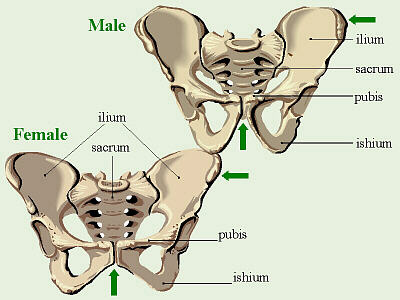
The hip joint is a major weight-bearing joint. It is also instrumental in balance and in movement of the leg. The hip joint is a ball and socket joint between the cup-like acetabulum of the pelvic girdle and the femoral head of the femur (thighbone). The bones are separated by a layer of cartilage, which cushions the joint, and a synovial membrane, which produces a fluid intended to lubricate the joint. Together, the cartilage and synovial fluid allow for easy, near-frictionless movement. [1][2][15]
The pelvic girdle consists of two hip bones, which are each made of three main parts: the ilium, the ischium, and the pubis. As shown in the figure, the upper region of the hip bone is the ilium. This section forms the sacroiliac joint. The ilium supports the sacrum on either side, which in turn supports the spine. The ischium is the bottom posterior piece of the bony hip. This is the part upon which humans sit. The pubis is the bottom anterior part, and the two pubic bones are connected by fibrous cartilage. This is also where the bladder resides within the human body. The large socket seen in the hip structure toward the bottom is known as the acetabulum. This is the socket of the ball and socket hip joint.
Types of Hip Arthroplasty
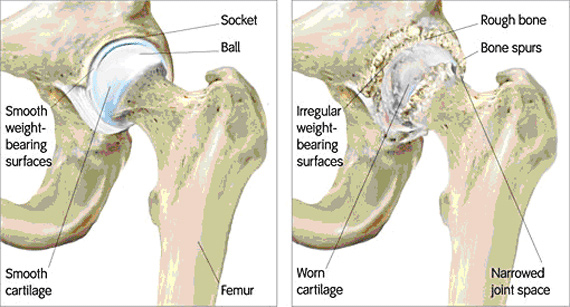
Typically, hip arthroplasty is necessary for individuals with a damaged hip joint that results in disability or pain that does not abate and inhibits normal activities and for whom alternative therapies have not worked. [19] Osteoarthritis of the hip joint is the most common reason for hip replacements. Other causes include rheumatoid arthritis, osteonecrosis, bone tumors, fractures, or other major joint injuries. [6][10] Most hip arthropathy patients are between the ages of 50 and 80. However, recommendations for surgery or other treatment are based primarily on each patient’s condition and circumstances, not on age or on other factors, such as weight.
There are three main types of hip arthroplasty:
Hip Hemiarthroplasty - In a hip hemiarthroplasty (partial hip replacement) only the femoral head is replaced, with the acetabulum remaining intact. A hip hemiarthroplasty is often a viable option in the event of a facture to the upper femur, commonly know as a hip fracture. [2][16]
Total Hip Arthroplasty (THA) – In a THA, both the femoral head and the acetabulum are replaced. Many patients with osteoarthritis will eventually need this procedure. [17]
A THA can be done with or without cement. Cemented replacements most commonly use polymethylmethacrylate as the cement, and patients with such surgeries can usually move well soon after the surgery. The procedure is generally successful. However, if a cemented replacement fails it is generally due to a loosening or cracking of the cement over time, resulting in instability. Further, debris from the loose cement can cause inflammation of the joint and weakening of the bone. Loosening can be exacerbated in patients who are active or overweight. [2]
Cementless replacements are those which are directly attached to the bone without the need of cement. The surface of such implants are often porous or textured to promote bone growth and adhesion. Such adhesion is crucial to the success of the procedure, so motion directly following the procedure is usually assisted in order to allow the bone time to grow and adhere to implant. Cementless implants are still being developed, but they are generally used in younger patients who tend to be more active and have better overall bone quality. [2]
Hip Resurfacing – Hip resurfacing is a new and increasingly popular procedure. In this procedure only the acetabulum is replaced. The cartilage is removed, and the femoral head is given a smooth metal cap, affixed with cement. While this procedure is too new to accurately assess its long-term success, there is evidence both of potential benefits and drawbacks. For instance, hip resurfacing may render revisions (subsequent replacement or adjustment surgery) easier, help prevent dislocations, allow patients to walk more naturally, and give them greater range of motion. However, it may increase the risk of femoral neck fractures and adverse health effects from metal ions entering the bloodstream. [2][18]
History
1821 – Anthony White performs the first excision arthroplasty in London, removing the head, neck, trochanters from the femur. This lessened his patient’s pain and allowed for mobility but not stability. [3]
1826 – John Rhea Barton performs the first osteotomy, an intertrochanteric osteotomy in Philadelphia. He cut the bone through the greater trochanter and some of the neck. Starting 20 days later, he induced regular motion of the patient’s leg to prevent the two sides of the bone from reuniting, thus creating a pseudarthrosis. The patient could walk with a cane three months later, but could not move the hip at all six months after the operation. This procedure grew in popularity, despite consistent long-term failure. Additionally, only half of intertrochanteric osteotomy patients survived the operation. [3]
1885 – In Lyon, France, Léopold Ollier develops a procedure for interpositional hip arthroplasty with adipose tissue. He did not have much success, in part because the adipose tissue was not attached to the bone, and thus did not stay in place. [3][11]
Late 1800s – Vitezlav Chlumsky, a Czech surgeon, attempts interpositional hip arthroplasty with a wide variety of materials, including glass, silver, celluloid, muscle tissue, rubber, glass, zinc, wax, and magnesium. [3]
1891 – Themistocles Glück of Berlin creates a prosthetic ball and socket joint made of ivory and attached with nickel-plated screws. He would go on to use and adhesive he developed using plaster of Paris, pumicite and resin. [3]
1912 – Sir Robert Jones uses gold foil in an interpositional arthroplasty. A follow-up 21 years after the operation revealed the patient still had full use of the hip. [3]
1915 – Chicagoan John Benjamin Murphy outlines a procedure called hip cheilotomy. It consists solely of removing osteophytes (bone spurs) from the hip joint. [3]
1918 – Pig bladder is a popular choice for an interpositional material at John Hopkins Hospital. [3]
1923 – Marius Smith-Peterson, a Boston-based surgeon, began experimenting with mold interpositional arthroplasty. He used glass for his first attempt, but soon found that these would break. He would go on try materials such as Pyrex glass (1933) and Vitallium (1938). The Vitallium (a lightweight, durable alloy of cobalt, chromium, and molybdenum) molds were generally successful. [3][12]
1940s – By this time it had become common to remove the femoral head of hip arthroplasty patients. In the words of Gathorne Robert Girdlestone, “If thine femoral head offend thee, pluck it out and cast it from thee.” [3]
1948 – Robert and Jean Judet of Paris, France, develop an acrylic prosthesis using methylmethacrylate. It failed because it wore out quickly, but the popularity of the idea remained. [3][13]
1950 – Frederick R. Thompson, inspired by the Judet brothers, refines a Vitallium prosthetic hip originally developed and used by Harold R. Böhlman and Austin Moore in 1940. [3][4]
1952 – Böhlman and Moore add a porous surface to their design to encourage bone growth and attachment to the prosthesis. [3]
1962 – Sir John Charnley introduces a revolutionary prosthetic hip with very low friction due to a smaller femoral head made of stainless steel and a high molecular weight polyethylene acetabular cup. (He had previously used a Teflon coating instead of the polyethylene, without success.) Charnley also developed bone cement and a clean air operating enclosure to reduce infection. Taken together, these developments comprise the first truly modern THA. [5][14]
1964 – Peter Ring introduces a cementless metal-on-metal prosthesis. While he experience good results, his model soon fell out of favor with surgeons. However, this trend was reversed beginning in the 1980s, and Ring’s model is still an option for patients today. [3]
Hip Prosthetics
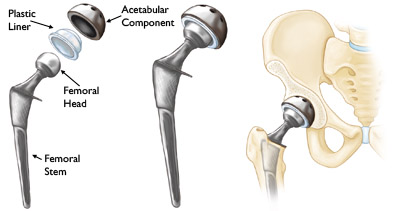
The total hip replacement implant consists of several parts. A typical hip prosthesis is pictured in the accompanying image. An acetabular shell, typically a metal or polyethylene material, becomes the socket of the joint. A liner, often made of polyethylene is frequently added as a cushion, functioning in an analogous manner to the cartilage present in a healthy joint. The stem, which is inserted into the femur, and the ball are usually made of a titanium or cobalt-chromium alloy. Each insert is custom-sized for each patient. Some also feature a porous surface to encourage bone growth and adhesion. [2][10]
Surgical Procedure
Standard Surgery
Source D: Short Video on Anterior Hip replacement Surgery |
Standard hip replacement surgery consists of several primary steps. The first step is to make an incision through the skin, tissue, and muscle layers over the hip joint. Next, the femoral head is dislocated and removed with a bone saw. A reamer is used to clean and shape antecebelum to fit the antecebular cup. The acetabular shell is then implanted. Bone cement is a common choice to hold it in place, but other methods are also used. The liner is then added to the cup. This will be in contact with the new femoral head once fully assembled. Before adding the femoral stem, the surgeon will typically remove any osteophytes remaining around the hip socket. Osteophytes, or bone spurs, are small bone growths that occur due to overcompensation of stressed joints. Using tools such an osteotome, the surgeon will then cut a canal in the femur and implant the stem. A trial ball is then placed on the newly implanted stem. This is used to test the range of motion of the hip and ensure that the joint will be stable. When the surgeon is satisfied, the final ball is put onto the stem in place of the test ball, and the leg is tested again for motion and stability. Leg length is also evaluated. Finally, the surgeon will close the opening and seal the wound with stitches and staples. [7][8]
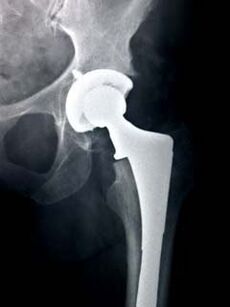
Incision Variations
Source E: In-Depth Video on Minimally Invasive Hip replacement Surgery |
Among the most significant variations in hip surgery is the location of the incision. The primary approaches are described:
Posterior – The posterior approach is a common strategy that involves an incision near the buttocks. It necessitates the removal of some muscles from the femur, but they are reattached later. Additionally, it may lead to increased risk of dislocation. [20]
Lateral – With the lateral approach, the incision is made in the side of the patients. It involves cutting two large muscles, which can cause the patient to develop a limp. [21]
Anterior – Using the anterior approach, the incision is made towards the front of the patient. No muscles are cut. Rather, they are shifted away from the hip joint during the operation. [21]
Minimally Invasive Surgery
Minimally invasive hip replacement surgery follows a similar procedure to that of the standard surgery. The major difference between the two procedures is that for the minimally invasive surgery, the incision is much smaller, typically only 3-4 inches long. The smaller incision results in reduced recovery time as well as a decreased risk of damaging tissues, nerves, or muscles. [9] A full surgery of this type is shown in the video.
Complications
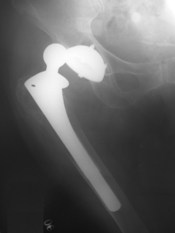
As with any surgery, complications are possible following the implanting of a replacement hip.
Dislocation - One such complication is dislocation of the hip, which happens when the new ball comes out of the socket. This is uncommon and can usually be remedied by a reduction of the hip. Only if it continues to occur would further surgery be necessary. [10]
Blood Clots - The most common complication associated with the surgery is blood clots. Blood clots are dangerous, as they can develop into pulmonary embolisms, but in most cases a post-surgery program to keep clots from forming, often involving the use of blood thinners, is sufficient. [10]
Infection – Infection is a risk with any surgery, and hip arthroplasty is no exception. Infections are typically treated with antibiotics. If the infection spreads to the implant, further surgery and possibly the removal of the prosthesis may be necessary. [10]
Wear and Loosening - Over time, patients may experience wearing or loosening of the prosthesis. If this becomes painful, a revision may be needed.
Unequal Leg Length - Although it is common practice to try to keep leg length constant, there may be a need to alter it in order to keep the prosthesis stabilized. Some who find this complication uncomfortable have remedied it using a simple shoe lift. [10]
References
[1] Sanders, Tina. "The Skeletal System." Understanding Human Structure and Function. By Valerie C. Scanlon. Philadelphia: F.A. Davis, 1997. 82-107. Print.
[2] "Hip Implants." OrthoInfo. American Academy of Orthapedic Surgeons, Oct. 2007. Web. 04 Feb. 2013. <http://orthoinfo.aaos.org/topic.cfm?topic=A00355>.
[3] Gomez, Pablo F., MD, and Jose A. Morcuende, MD, PhD. "Early Attempts at Hip Arthroplasty: 1700s to 1950s." The Iowa Orthopaedic Journal (2005): 25-29. U.S. National Library of Medicine. Web. 3 Feb. 2013. <http://www.ncbi.nlm.nih.gov/pmc/articles/PMC1888777/>.
[4] Kaminski, M., J. Baszkiewicz, J. Kozubowski, A. Bednarska, A. Barcz, G. Gawlik, and J. Jagielski. "Effect of Silicon Ion Implantation on the Properties of a Cast Co-Cr-Mo Alloy." JOURNAL OF MATERIALS SCIENCE (1997): 3727-732. Print.
[5] Pospula, Wieslaw. "Total Hip Replacement: Past, Present and Future." Kuwait Medical Journal (2004): 250-55. Print.
[6] "What Is a Hip Replacement?" National Institute of Arthritis and Muskuloskeletal and Skin Diseases. National Institutes of Health, Department of Health and Human Services, July 2010. Web. 04 Feb. 2013. <http://www.niams.nih.gov/health_info/Hip_Replacement/hip_replacement_ff.asp>.
[7] "The Surgical Procedure for Total Hip Replacement." Stryker. Stryker Corporation, n.d. Web. 4 Feb. 2013. <http://www.aboutstryker.com/pdfs/hip_replacement.pdf>.
[8] "Virtual Hip Replacement Surgery." Edheads. Zimmer, Inc., n.d. Web. 04 Feb. 2013. <http://www.edheads.org/activities/hip/glossary.shtml>.
[9] "Minimally Invasive Hip Surgery (MIS)." Minimally Invasive Hip Replacement. Stryker Corporation, n.d. Web. 04 Feb. 2013. <http://www.aboutstryker.com/hip/procedures/procedures-mis.php>.
[10] "Total Hip Replacement." OrthoInfo. American Academy of Orthapedic Surgeons, Dec. 2011. Web. 04 Feb. 2013. <http://orthoinfo.aaos.org/topic.cfm?topic=A00377>.
[11] St. Clair SF, Higuera C, Krebs V, et al. “Hip and Knee Arthroplasty in the Geriatric Population.” Clinics in Geriatric Medicine. 2006; 22; 515-533. Available from: http://www.ncbi.nlm.nih.gov/pubmed/16860243. Accessed February 18, 2014.
[12] Smith-Peterson MN. Lecture on Evolution of Mould Athroplasty of the Hip Joint. May 1947. Available from: http://www.bjj.boneandjoint.org.uk/content/30-B/1/59.full.pdf?origin=publication_detail. Accessed February 18, 2014.
[13] Sampager AJ, Lecture on Total Hip Athroplasty. September 14, 2011. Available from: http://www.slideshare.net/dranandranjan/total-hip-arthroplasty-16626182. Accessed February 19, 2014.
[14] Wroblewski BM. “Professor Sir John Charnley (1911-1982).” Rheumatology. 2002; 41 (7); 824-825. Available from doi: 10.1093/rheumatology/41.7.824. Accessed February 19, 2014.
[15] “The Hip.” Available from: http://www.pt.ntu.edu.tw/hmchai/Kines04/KINlower/Hip.htm. Accessed February 19, 2014.
[16] American Academy of Orthopaedic Surgeons. “Orthoinfo: Hip Fractures.” Available from: http://orthoinfo.aaos.org/topic.cfm?topic=A00392. Accessed February 19, 2014.
[17] Cibulka MT, White DM, Woehrle J, et al. “Hip Pain and Mobility Deficits – Hip Osteoarthritis: Clinical Practice Guidelines Linked to the International Classification of Functioning, Disability, and Health from the Orthopaedic Section of the American Physical Therapy Association.” Journal of Orthopaedic & Sports Physical Therapy 2009;39(4):A1-A25. Available from doi:10.2519/jospt.2009.0301. Accessed February 19, 2014.
[18] American Academy of Orthopaedic Surgeons. “Orthoinfo: Hip Resurfacing.” Available from: http://orthoinfo.aaos.org/topic.cfm?topic=A00586. Accessed February 19, 2014.
[19] “Hip Replacement Surgery.” John Hopkins Medicine. Available from: http://www.hopkinsmedicine.org/healthlibrary/test_procedures/orthopaedic/hip_replacement_surgery_procedure_92,P07674/. Accessed February 19, 2014.
[20] “Posterior Approach to Hip Replacement Surgery.” Duke Orthopaedics. Available from: http://www.dukehealth.org/orthopaedics/services/joint-replacement/treatments/total-hip-replacement/posterior-approach-to-total-hip-replacement-surgery. Accessed February 19, 2014.
[21] Bal S, Turpin S, “Hip Replacement Surgery: a comparison of three approaches: anterior, lateral and posterior.” Missouri Orthopaedic Institute: University of Missouri Health Care. 2008-2009; Available from: http://medicine.missouri.edu/ortho/Bal/docs/hipbrochure.pdf. Accessed February 19, 2014.
Images and Video
[A] http://biology.clc.uc.edu/courses/bio105/bone.htm
[B] http://www.kingorthopedics.com/hip-osteoarthritis.html
[C] http://orthoinfo.aaos.org/topic.cfm?topic=a00377
[D] Stefan Kreuzer, MD., http://www.youtube.com/watch?v=HRki3UDYa08
[E] Barry Waldman, MD., http://www.youtube.com/watch?v=-hm2ogoSc1Y
[F] http://onsmd.com/condition_treatment/hip-replacement-surgery/
